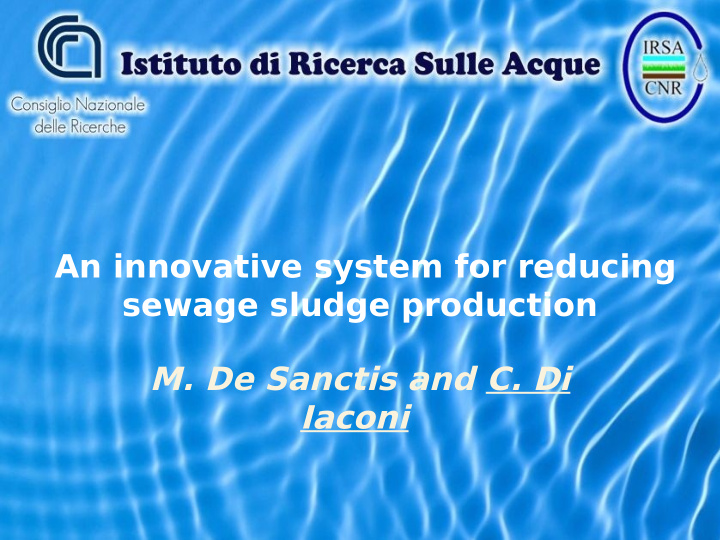



An innovative system for reducing sewage sludge production M. De Sanctis and C. Di Iaconi
Problem defjnition The management of sludge originating from wastewater treatment plants is currently one of the most critical issues of the whole treatment cycle of municipal sewage. In fact, although the sludge volume produced by sewage treatment plant represents only 1% of the volume of sewage fmowing in the plant, its treatment and fjnal disposal entail up to 60% of the total operating costs of the plant. water line water line sludge line sludge line conventional sewage treatment plant
Sewage sludge reduction Several techniques for sludge minimization have been proposed in the last decade although their application at the full scale is still relatively limited. These approaches can be classifjed on the basis of the location of the plant where minimization takes place: Techniques for water line (“at source”) Techniques for sludge line (“downstream”) water line sludge line
Reducing sludge production in water line The main mechanisms exploited for sludge reduction in the water line are based on: 1) cell lysis and cryptic growth, 2) maintenance metabolism. 1) Cell lysis and cryptic growth 2) Maintenance metabolism Obstacles: Obstacles: Chemicals and operating conditions necessary for achieving signifjcant reductions of sludge production can low biomass settling velocity negatively afgect the purifjcation process as well as make biomass suspension and it expensive. mixing
MULESL: a maintenance metabolism based system In the last decade, a new system, whose acronym is MULESL (Much Less SLudge), with sludge age greater than 120 days was developed by the Water Research Institute of Italian CNR. MULESL can be obtained by converting the biological stage of the conventional WWTP . MULESL allows to transform the existing activated sludge in a particular kind of sludge made up of biofjlm and granules bounded in a plastic porous material. Thanks to its physical and biomass features, MULESL allows to obtain the separation of the biomass from the liquid phase at the same time of the treatment, thus allowing to reach high biomass concentration without the need of sedimentation stage.
MULESL features No primary and secondary clarifjers High biomass concentration (up to 30 kg/m 3 ) Long sludge age (>120 days) Low sludge production (up to 80% less) Treatment scheme simplifjcation High quality effmuent MULE SL
Full scale MULESL In 2016 the fjrst demonstrative full scale plant based on MULESL system (3,500 PE) was designed and built in Putignano WWTP (Italy), by retrofjtting an existing AS unit. The plant came into operation at the end of 2017. MULESL unit existing AS unit
Sewage sludge reduction at full scale Putignano WWTP (28,000 PE) MULESL WWTP (3,500 PE)
Conventional vs MULESL WWTP Putignano WWTP (28,000 Flow (L/PE×d) = 128 Flow (L/PE×d) = 123.6 TSS (g/PE×d) = 80 TSS (g/PE×d) = 2.5 PE) COD (g/PE×d) = 120 COD (g/PE×d) = 6.2 TN (g/PE×d) =12 TN (g/PE×d) = 1.8 Flow (L/ P E × d ) = 4.4 TSS (g/ P E × d ) = 69.0 TN (g/ P E × d ) = 2.8 Flow (L/PE×d) 127. = 2 TSS 1.0 (g/PE×d) = COD 4.2 (g/PE×d) = TN 0.5 (g/PE×d) = MULESL WWTP lower TN and TS content in the (3,500 PE) Flow (L/PE×d) = 0.8 effmuent TSS (g/PE×d) = 15.6 TN (g/PE×d) = 0.6 sludge reduction of 77%
Conclusions A new system (MULESL) for reducing sewage sludge production in the water line of WWTP was successfully implemented at full scale by converting an existing AS basin; MULESL operated in parallel with the traditional water line of WWTP; A sludge reduction of 77% was obtained compared to the traditional water line based on primary and secondary treatment; An improvement of the effmuent quality was also observed, especially in terms of nitrogen and suspended solids.
THANK YOU! CONTACTS Claudio Di Iaconi Senior Research Scientist Water Research Insitute - CNR E-Mail: claudio.diiaconi@ba.irsa.cnr.it Claudio Di Iaconi
Recommend
More recommend